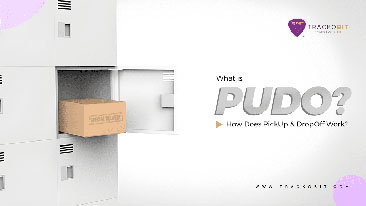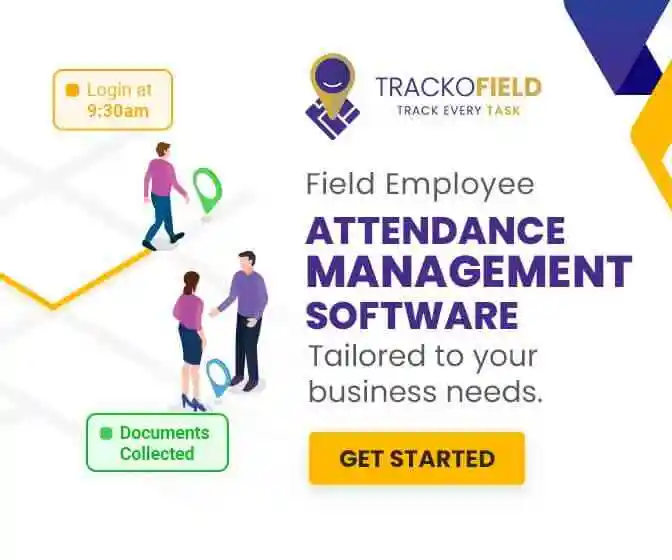-
TrackoBit
Manage commercial vehicles with the new-age Fleet Management Software
TrackoBit -
TrackoField
Streamline your scattered workforce with Field Force Management Software
TrackoField -
Features Resources
-
Blog
Carefully curated articles to update you on industrial trends. -
White Paper
Insightful papers and analysis on essential subject matters. -
Glossary
Explore an alphabetical list of relevant industry terms. -
What’s New
Get TrackoBit & TrackoField monthly updates here. -
Case Study
Explore the cases we solved with our diverse solutions. -
Comparisons
Compare platforms, features, and pricing to find your best fit.
-
About Us
Get to know TrackoBit: our team, ethos, values, and vision. -
Careers
Join the most dynamic cult of coders, creatives and changemakers. -
Tech Support
Learn about our technical support team and services in detail. -
Events
Check out the exhibitions where we left our marks and conquered. -
Contact Us
Connect with us and let us know how we can be of service.
Cracks in the System: Why Public Transport Needs Fleet Management Software
- Author:Anvesha Pandey
- Read Time:8 min
- Published:
Table of Contents
Toggle
Are city buses frequently running behind schedule or deviating routes? Explore how smart fleet management software solves public transport challenges with data, automation & insights.
Table of Contents
Toggle
City bus systems often struggle with missed stops, unpredictable ETAs, mid-route breakdowns, and a lack of real-time oversight. These aren’t just setbacks for the operations but also, they delay commuters & bleed resources.
Yet, many operators still rely on outdated planning methods. As the industry shifts toward smarter mobility, the need for digitization and data-driven decisions becomes critical.
That’s where fleet management software steps in. This helps in offering live tracking, intelligent route planning, instant alerts, and efficient resource use.
“Afterall, modern public transport is about reliability, responsiveness, and putting commuters first.”
This blog explores how fleet management software are transforming public transport. But first, let’s dive into the key challenges the sector must tackle.
The Cracks in the System: Why Public Bus Fleets Struggle Without Fleet Management
Despite being the backbone of urban mobility, public bus fleets even today continue to operate in silos.
Below is a list of some of the most prominent challenges-
1. Poor Trip Planning and Route Scheduling
Most city bus systems still rely on manual planning. They often use outdated data or static schedules that don’t reflect real-time conditions. This leads to overlapping routes, underutilised buses during off-peak hours & the over during rush hours.
The result?
Longer travel times, missed stops, and inefficient fleet utilisation that drains both time and fuel.
That’s just not all, this also means frequent rescheduling, confusion among commuters & additional pressure on drivers & operators.
2. Inconsistent ETAs and Unreliable Schedules
One of the major pain points for commuters is the unpredictability of buses. In the absence of real-time tracking & communication tools. In fact, at times, buses arrive late from pre-defined times or don’t arrive at all.
Without a centralized fleet management system monitoring fleet movement, operators have no accurate way of predicting or updating ETAs.
This not only frustrates commuters but also reduces trust.
3. Lack of Real-Time Communication Between Drivers and Control Rooms
When a bus breaks down, hits unexpected traffic, or needs route guidance (in case of any exception), drivers often have no direct line to the control room. This communication gap delays decisions, slows incident response, and increases risk—especially in emergencies.
It also prevents public fleet managers from intervening in real-time to redirect buses, inform commuters, or coordinate support teams. Ultimately affecting service continuity and safety.
4. High Fuel Consumption and Inefficient Routing
Talking about fuel expenses, it is one of the biggest operational costs in public transport. Poor route planning combined with prolonged idling & unnecessary detours leads to excessive fuel consumption.
Additionally, the absence of route analytics and vehicle usage monitoring means fuel wastage often goes unnoticed. Inefficiencies like harsh braking, overspeed, or long engine idle times also contribute to increased fuel expenses.
5. Manual Reporting, Poor Compliance, and Data Gaps
In most of the public transport fleets, reporting is still done via scattered Excel sheets. This leads to missing data, delays in performance analysis & human errors.
In such scenarios, it becomes difficult to track important metrics like the assigned route & the actual route, driver behavior or even fuel usage. As a result, compliance with safety regulations or audits becomes challenging.
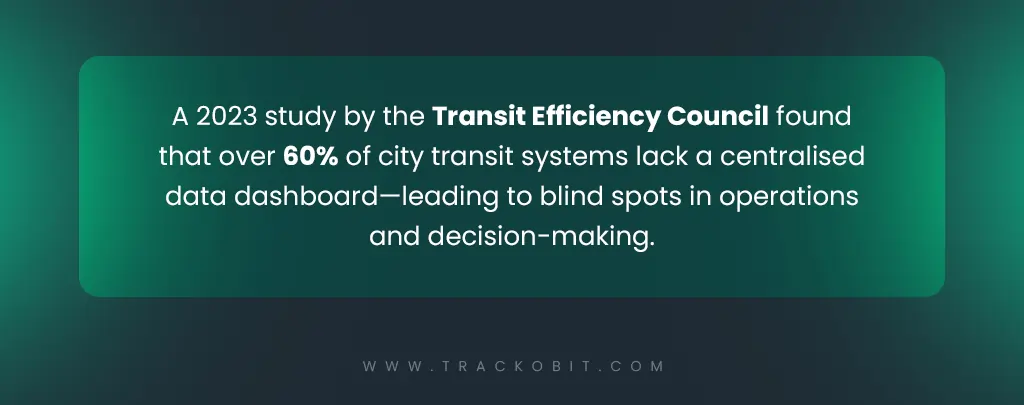
Have insights into Stats!
Now that we’ve uncovered the cracks in the system, let’s explore how modern fleet management solutions are stepping in to fix them.
Fix it with a Fleet Management System!
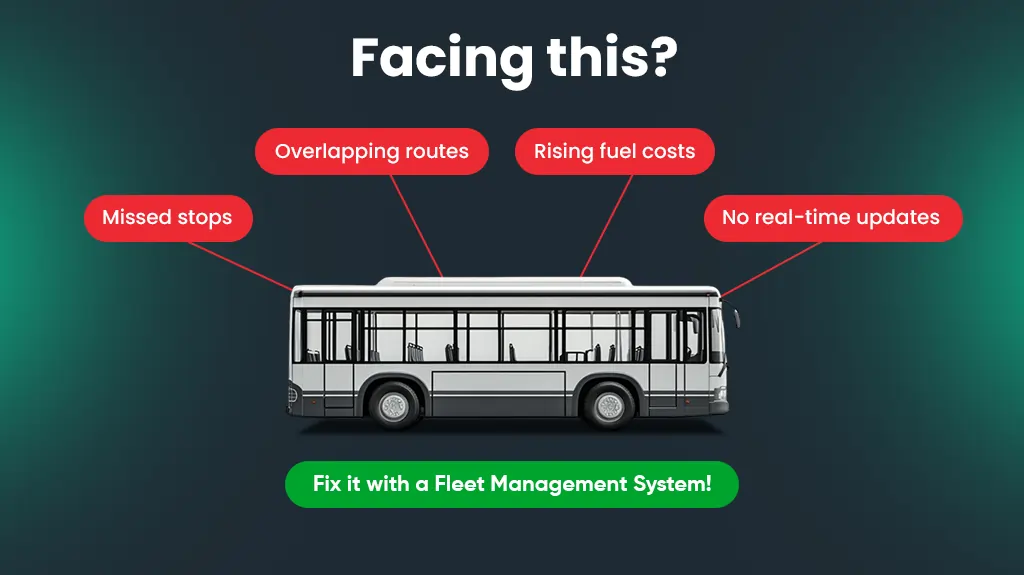
The problems & the fix
How Fleet Management Systems Are Redefining Public Transport?
We’ve seen how public transport systems struggle with outdated operations & recurring inefficiencies. When a fleet management software comes into the big picture, authorities regain control, boost reliability & modernize operations.
Here’s how an ideal fleet management software helps!
1. Smart Route Planning & Trips Management
Most public transport requires managing fixed routes and schedules, but they fail to take dynamic problems into account. Having smart & efficient planned routes ensures better frequency, reduces overlap between routes. It also helps utilise the fleet more efficiently.
Simply put, when routes are well-planned, buses move more predictably, passengers face fewer delays, and operations run with far less confusion.
So, How Does Route Planning Actually Work?
It all starts with intelligent route planning and trip creation. Using the fleet management system, central admins can pre-define routes by setting start and end points, along with halts.
Once the trip begins, live tracking is activated. The system continuously monitors the bus’s location, speed, and adherence to the planned route. If a bus deviates, misses a stop, or runs late at any halt, the control room gets instant alerts for corrective action.
After the trip, detailed reports are curated showcasing how the route went, delays, deviations, all of it.
All of this can take place with the help of fleet management software!
2. Intelligent Fuel Monitoring
The fleet management system paired with a fuel monitoring solution helps track fuel consumption at a granular level. So, whether it’s excessive idling, aggressive driving, or inefficient routing, the system picks it up instantly. Alerts are triggered in case of sudden fuel drops. Further it helps prevent theft or detect maintenance issues early.
For instance, it identifies underperforming routes where fuel consumption is higher than expected, helping optimize routes for better efficiency. It also flags drivers with excessive fuel consumption
3. Min-to-Min Fleet Visibility
With real-time tracking, fleet managers can monitor every bus in motion- down to the minute. Whether it’s checking if a vehicle is following it assigned up & down route or not, running on time or stopping at the halt’s aka bus stops or not.
This level of tracking reduces blind spots, improves route adherence, and helps maintain service reliability throughout the day.
4. Driver Behavior Monitoring
How a driver operates the vehicle has a direct impact on commuter safety, vehicle health, and fuel usage. Fleet management software with driver behaviour monitoring solutions help capture driving patterns like harsh braking, overspeeding, sharp turns, and long idling periods.
These insights not only help in training drivers for safer and more economical driving but also in recognizing and rewarding responsible driving behavior.
This is how this works!
Think of it like a driving report card. Fleet systems track how each bus is driven. The system flags things like harsh brakes, speeding, or long idles as violations.
Each alert pops up live, tagged to the driver and route. Over time, this builds a clear picture of who’s driving safely and who needs training. Further helping boost safety, cut fuel waste, and reward good behavior on the road.
5. Central Command Dashboard
All live data—from vehicle location to fuel levels and driver activity—flows into one centralized dashboard. This command center becomes the operational brain that offers a real-time overview of the entire fleet.
From here, authorities can respond to emergencies, dispatch support, update schedules, and coordinate more efficiently across teams. It turns a chaotic system into a simple presentation.
Having said all of this, the problems & the solutions- let’s picture all of this into a use case to see how the system helps!
Use Case: How a Leading Public Transport Brand Solved Operational Inefficiencies with TrackoBit
A prominent city bus operator, running over 500 vehicles daily showed up struggling with inefficiencies. They faced challenges like:
- Clashed Schedules
- Manual Reporting
- Inefficient Route Planning
- Raising Cost
With growing commuter dissatisfaction and rising operational pressure, the need for a smarter system became undeniable.
Let’s have a look how TB’S fleet management helped-
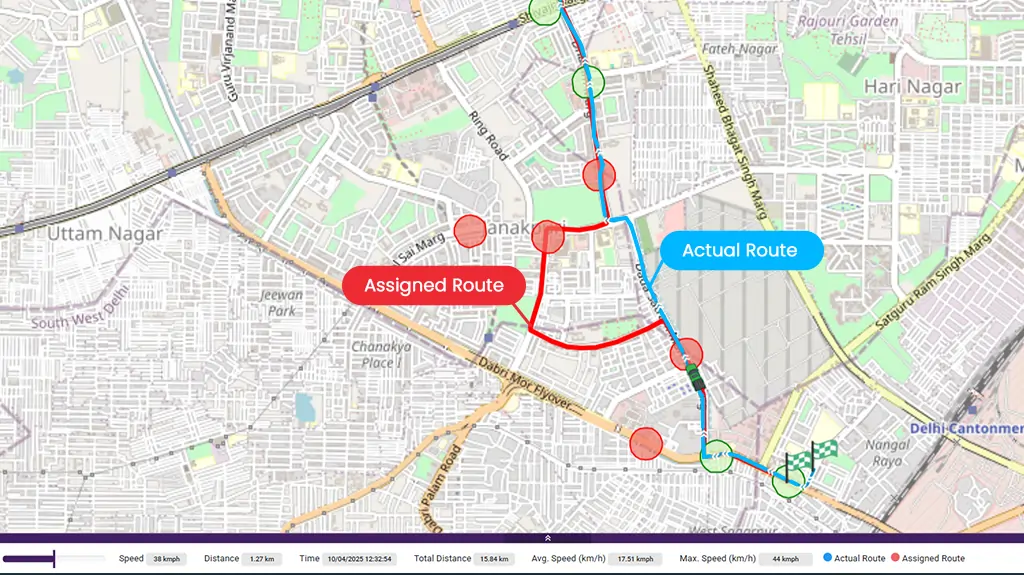
That’s how Route Planning UI Looks!
1. Rethinking Routes from the Ground Up
They decided to ditch the guesswork and went smart. Their predefined routes were digitally created with fixed up-and-down patterns, service timings, and stop sequences.
Each trip was linked to a specific bus and driver. The moment a vehicle hit the road, live tracking kicked in. Any detour, skipped stop, or delay was instantly flagged.
What made this shift even more powerful was route history management. Every completed trip is fed into a detailed report—comparing the assigned route with the actual path taken.
The Result: – Balanced route allocation, better visibility, real-time alerts, and consistent, reliable commuting experience!
2. Plugging Fuel Leaks Before They Drain Budgets
Fuel wastage was no longer a mystery. The fleet management software tracks tank levels, consumption trends, and behavioral patterns. Suspicious fuel drops triggered alerts. High-idling routes were flagged. Vehicles needing maintenance stood out.
The Result: Fuel consumption dropped by nearly 18% in just half a year.
3. Coaching, Not Just Correcting, Drivers
With every trip, the system captured how buses were being driven—right from speed spikes to unnecessary idling. Instead of just penalising poor driving, data was used to train and reward.
Drivers receive monthly performance dashboards. The good ones were recognised. The struggling ones got coached. Additionally, driver scorecards highlight key metrics like speed control, fuel efficiency, and idling time. This helps the fleet managers get a clear view of their strengths and areas for improvement.
Result: Safer driving culture, lower fuel burn, and fewer breakdowns.
4. One Command Centre, Total Control
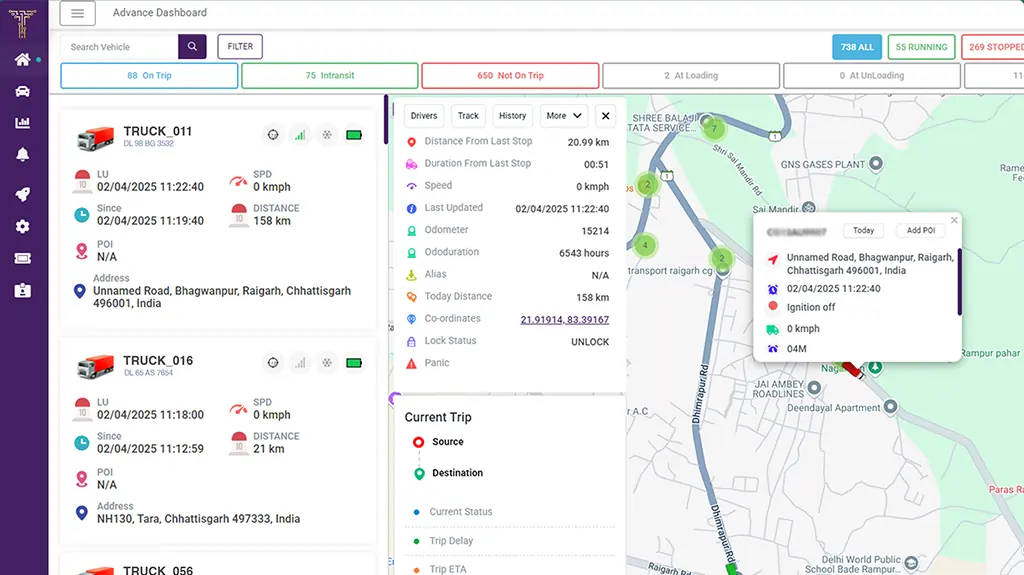
That’s how the “Central Dashboard” Appears!
Before, operations were scattered—siloed updates, paper logs, and Excel chaos. Now, all critical data like location, ETA, fuel stats, driver behavior all flowed into one dashboard.
Teams could take real-time actions, generate reports instantly, and plan with data—not assumptions.
The Result: Greater agility, faster response, and tighter control over daily operations.
The overall result?
After deploying a fleet management software, they saw
✅ 30% reduction in delays
✅ 20% improvement in fuel efficiency
✅ 3x faster incident response
✅ 40% drop in commuter complaints
In short, they started fixing routes racked buses live, and spotted detours in real time. Planning got sharper and trips got smoother.
The Road Ahead
In the words of Henry Ford, “If everyone is moving forward together, then success takes care of itself.” This isn’t just a catchy quote. It also showcases the transformation that smart fleet management brings to urban transit.
By ditching outdated manual systems and adopting an integrated approach, you can skip all that chaos & bring streamlined efficiency to the table.
Today’s transit isn’t only about moving from point A to B—it’s about delivering a smarter, safer, and more reliable service. With enhanced visibility, precise route management, and actionable insights, you can just not save time but also resources.
Afterall the goal is being “Reliable. Accessible. Efficient.”
So, are you ready to invest in an ideal fleet management software?
TrackoBit can be the perfect bet!
Get in touch to know more.
FAQs
-
Why is digitisation important in public transport?
It replaces manual guesswork with data-backed decisions. Further improving efficiency and commuter experience.
-
What kind of data do these systems collect?
They track location, speed, fuel usage, driver behavior, route history, engine diagnostics, and more.
-
Can these solutions help with government compliance?
Yes, they help maintain accurate records and reports that simplify audits, regulations, and grant processes.
-
Can fleet management systems work with existing public transport infrastructure?
Yes, most modern systems offer integration with legacy software, GPS hardware, and ticketing systems.
-
Is it expensive to implement fleet management in public transport?
While there's an initial cost, the long-term savings in fuel, maintenance, and operations often outweigh it.
Anvesha is a communication specialist at TrackoBit. With a strong background in media and communications, she adds much-needed balance and brevity to TrackoBit’s... Read More
Related Blogs
-

When Tracking Needs a Clock: Rethinking Fleet Visibility
Tithi Agarwal December 24, 2025Read on to understand why fleet tracking works better when it follows working hours. Because visibility should support operations, not…
-

What Makes TrackoBit’s Video Telematics Software Truly Next-Gen?
Shemanti Ghosh December 17, 2025TrackoBit’s video telematics software blends smart video intelligence with full server control. The result? Superior fleet reliability and safety.
-

Plug, Pair, Perform TrackoBit Introduces BLE Sensor Integration
Tithi Agarwal November 26, 2025TrackoBit’s BLE Sensor Integration enables wireless, real-time monitoring with faster installs and accurate insights. It improves fleet efficiency, visibility, and…
-
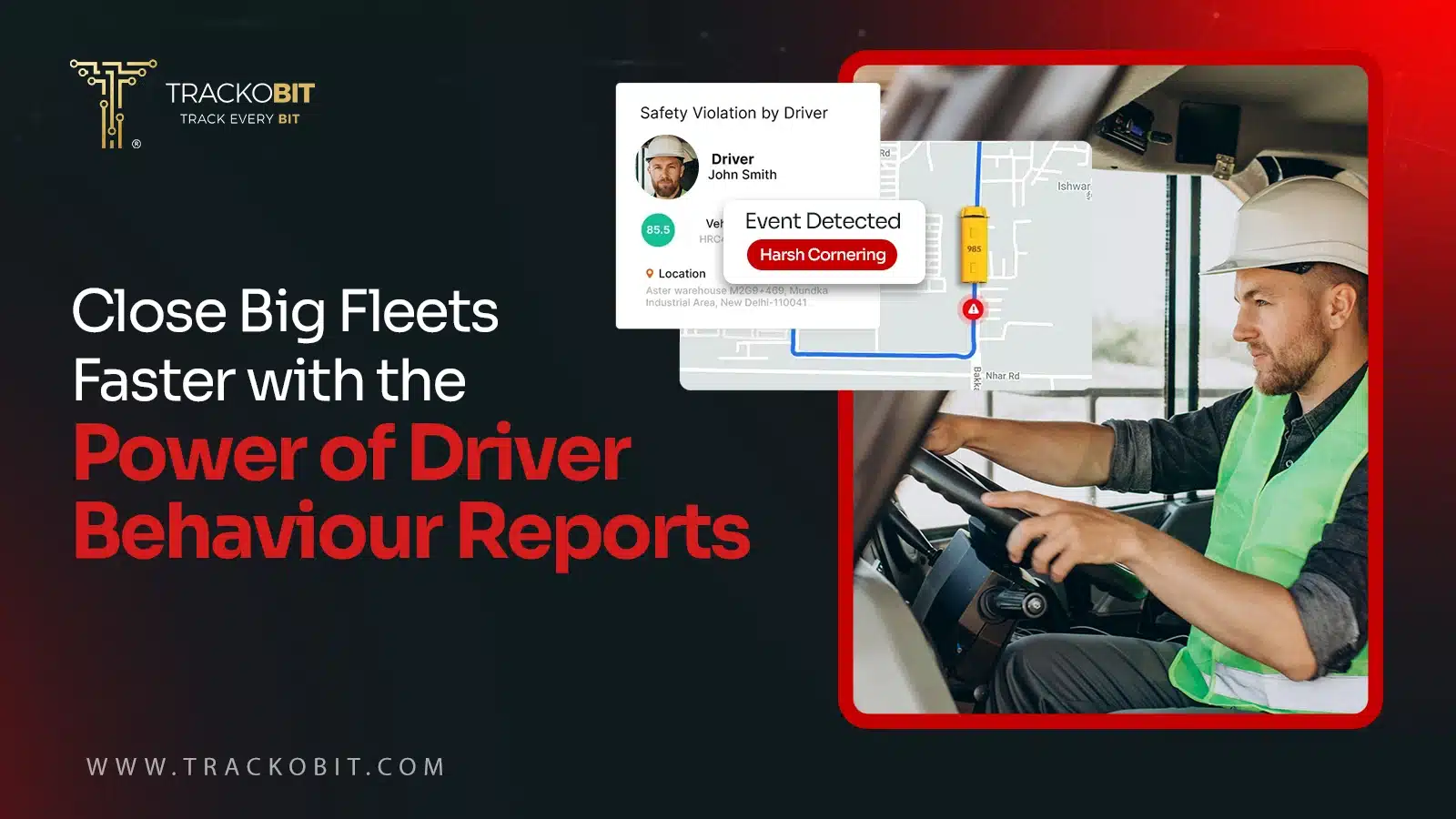
How to Use Driver Behavior Reports as a Sales Hook to Close Big Fleets
Tithi Agarwal October 16, 2025TrackoBit’s driver behavior reports empower fleet providers to win big contracts by showcasing safety, efficiency, and measurable ROI.

Subscribe for weekly tips to optimize your fleet’s potential!
Your inbox awaits a welcome email. Stay tuned for the latest blog updates & expert insights.
"While you're here, dive into some more reads or grab quick bites from our social platforms!"Stay Updated on tech, telematics and mobility. Don't miss out on the latest in the industry.
We use cookies to enhance and personalize your browsing experience. By continuing to use our website, you agree to our Privacy Policy.
































